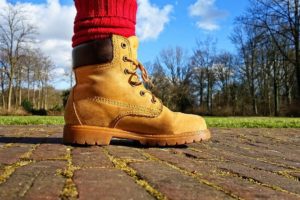
heir toughness can bear the brunt of snakebites as well to keep you safe.
However, are they enough to protect you from snakes that strike viciously to transfer venom? You don’t want to find the answer to that the hard way.
Most snakebites lack the power required to break through the rigidness of leather boots.
But, you are doomed if you come across a type whose fangs are the longest, the sharpest, and worst of all, full of venom.
Snakeproof leather boots don’t let the venom come close to your skin. What do they have that traditional leather boots don’t? Head below to find out.
Table of Contents
Can Snakes Bite Through Leather Boots?
No, snakes cannot bite through leather boots.
Before you slump back in relief, there is a but coming. Small snakes are unable to breach the barrier of leather boots.
But, a bigger and poisonous one, for instance, a long copperhead? It might lack the strength, but it makes up for that with the length of fangs – a large copperhead can have up to 2-inch long retractable fangs.
If you come across a 29” or 30” copperhead, your traditional leather boots will protect you as much as flip-flops.
What Type of Snakes Can Bite Through Leather Cowboy Boots?
Another formidable opponent that you need to be wary of is a rattlesnake.
A rattlesnake can grow as large as 8ft. That monstrous creature can have 1-inch long fangs and can strike with a pressure higher than 150psi when hit directly. Your leather boots do not stand a chance against such statistics.
The bottom of the feet will be protected because of the thick soles.
However, the top and side of your foot and calf region are fair game. A rattler strikes in five-tenth of a second – not enough time for you to retreat or prepare your offensive strategy.
According to the National Snakebite Registry’s statistics of 2017, 4071 attacks of pit viper were reported, 2035 of Copperheads, 753 rattlesnake bites and 255 of cottonmouths. They are some of the most dangerous species of snakes and are a native of North America. Their bite may not be fatal, but it will lead you to the emergency room; don’t doubt that.
What Materials Can Offer Protection?
Your end game is to make it impossible for such vicious snakes to permeate through the barriers to reach your skin. Cowboy boots offer resistance due to their thickness and durability, but you know they aren’t 100% impenetrable.
Wear loose-fitting denim or canvas pants that reach the ankle of your boots. A little overkill with protection will save you from a helluva pain and damage, so add a layer of anti-snake gaiters, chaps or snake-proof leggings.
These are usually composed of tough nylon, Cordura or synthetic materials that fangs cannot penetrate through.
What Kind of Leather Boots will Keep You Safe from Fangs?
The kind that says “snakeproof”. Leather cowboy boots were basically designed for horse riding.
While they may have some features like a tall shaft and rugged sole to offer some protection against snakebites, they lack plenty of others to shield your vulnerable lower leg completely.
However, you can still find companies that manufacture protective footwear in cowboy style. Just make sure that the boots have the following characteristics:
Snake Guard:
Protective leather boots have a special protection layer often termed “SnakeGuard Technology” to prevent the fangs from coming anywhere near your flesh.
Coverage:
Since snakes can crawl up your foot to your shin and calf, the coverage of your shoes matters a lot. The longer your boots are, the more protected your leg will be.
Most of the snakes’ attacks occur between the ankle and the knee section. Therefore, the shortest length acceptable is up to the mid-calf.
Expert hunters and hikers will advise you to go for maximum coverage, i.e. 16 – 18 inches tall boots. This much height can extend protection up to your knee, keeping you safe from larger snakes too.
Fit:
Do buy the sturdiest pair, but make sure the insides have comfortable footbeds and linings as your feet will be enclosed in them for hours on end.
The boots with stiff insides will chafe and injure your skin, making it hard to keep walking in them. Your shoes should be snakeproof but with flexible weak points to not hinder your movement.
Breathable:
Knee-high boots with so many layers and stiff exterior tend to get stuffy and suffocating, leading to excessive sweating and awful odor.
You need proper air circulation to avoid that. The boots containing a breathable fabric and moisture-wicking characteristics will prevent the accumulation of moisture and stench, thereby keeping your feet dry and calm even in summers.
Besides, the boots should also be waterproof so that you could pass through muddy and swamp-filled areas too.
Closing Technique:
The closure technique of shoes can also affect the protection against venom. Zippers and slip-on are easy to put on/off, but the former has a tendency to get stuck in bushes while the latter needs extra attention to measurements to get a perfect size.
Laces are ideal for a snug and comfortable fit, but they also tend to get tangled in bushes and twigs, not to mention tying/untying them is time-consuming.
Choose those boots that combine a closure method with buckle clips to attain ease and comfort without compromising safety.
Conclusion
Hence proved: leather boots can offer more protection against snakebites than rubber boots or work boots, but they’re not 100% safe from all types of snakebites. Only heavy materials and snakeproof leather boots will keep you safe from the venom of these vicious creatures. Therefore, cover yourself in proper protective attire when going through snake-infested terrains if you want to return home without making a detour to ER.
